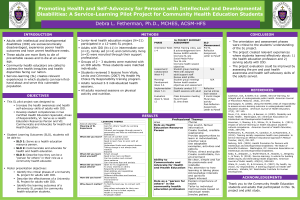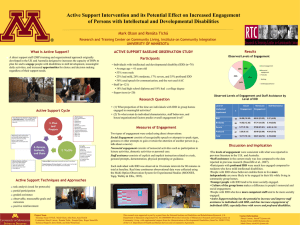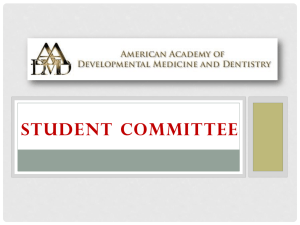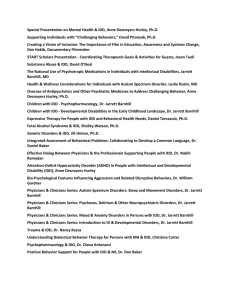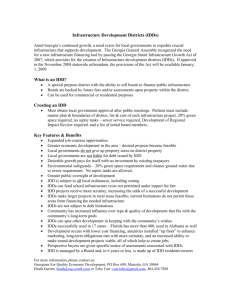executive summary - University of Rochester Medical Center
advertisement
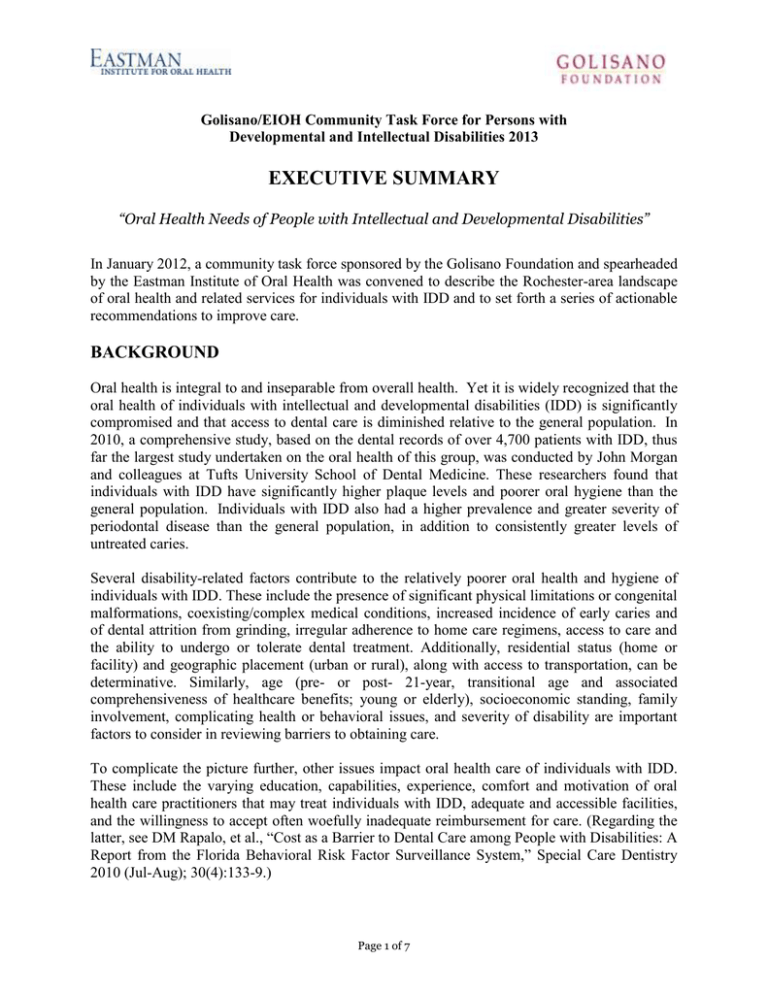
Golisano/EIOH Community Task Force for Persons with Developmental and Intellectual Disabilities 2013 EXECUTIVE SUMMARY “Oral Health Needs of People with Intellectual and Developmental Disabilities” In January 2012, a community task force sponsored by the Golisano Foundation and spearheaded by the Eastman Institute of Oral Health was convened to describe the Rochester-area landscape of oral health and related services for individuals with IDD and to set forth a series of actionable recommendations to improve care. BACKGROUND Oral health is integral to and inseparable from overall health. Yet it is widely recognized that the oral health of individuals with intellectual and developmental disabilities (IDD) is significantly compromised and that access to dental care is diminished relative to the general population. In 2010, a comprehensive study, based on the dental records of over 4,700 patients with IDD, thus far the largest study undertaken on the oral health of this group, was conducted by John Morgan and colleagues at Tufts University School of Dental Medicine. These researchers found that individuals with IDD have significantly higher plaque levels and poorer oral hygiene than the general population. Individuals with IDD also had a higher prevalence and greater severity of periodontal disease than the general population, in addition to consistently greater levels of untreated caries. Several disability-related factors contribute to the relatively poorer oral health and hygiene of individuals with IDD. These include the presence of significant physical limitations or congenital malformations, coexisting/complex medical conditions, increased incidence of early caries and of dental attrition from grinding, irregular adherence to home care regimens, access to care and the ability to undergo or tolerate dental treatment. Additionally, residential status (home or facility) and geographic placement (urban or rural), along with access to transportation, can be determinative. Similarly, age (pre- or post- 21-year, transitional age and associated comprehensiveness of healthcare benefits; young or elderly), socioeconomic standing, family involvement, complicating health or behavioral issues, and severity of disability are important factors to consider in reviewing barriers to obtaining care. To complicate the picture further, other issues impact oral health care of individuals with IDD. These include the varying education, capabilities, experience, comfort and motivation of oral health care practitioners that may treat individuals with IDD, adequate and accessible facilities, and the willingness to accept often woefully inadequate reimbursement for care. (Regarding the latter, see DM Rapalo, et al., “Cost as a Barrier to Dental Care among People with Disabilities: A Report from the Florida Behavioral Risk Factor Surveillance System,” Special Care Dentistry 2010 (Jul-Aug); 30(4):133-9.) Page 1 of 7 Golisano/EIOH Community Task Force for Persons with Developmental and Intellectual Disabilities 2013 The urgent need to systematically address oral health care needs among people with IDD is recognized at national and state levels, and comprehensive, integrated, and systematic responses are under development. Based on a meta-analysis of twenty-seven high quality research studies looking at oral health among individuals with IDD, Dr. Patrick Anders, faculty at SUNY Buffalo School of Dental Medicine, noted, “The greatest opportunity to improve oral health for people with intellectual disabilities lies in the development of effective prevention.” Special Care Dentistry 2010, May-June 30. Unfortunately this is sorely lacking. As Dr. William Calnon, former President of the American Dental Association, has said, “We can’t drill our way out of this problem.” Clearly, we have great strides to make and prevention appears to be a logical starting point. LOCAL CONTEXT The 10 county Finger Lakes Region is home to more than 12,000 individuals with IDD (representing a significant portion of the 126,000 individuals receiving services through the NYS Office for Persons with Developmental Disabilities (OPWDD). The vast majority of these individuals, in keeping with national trends toward de-institutionalization, live in communitybased group residences or at home with their families. Increasingly, these individuals look to providers in their communities to meet their dental care needs. However, while many individuals with IDD can theoretically be cared for in a general practice community setting, most general practice dentists are ill-prepared to provide coverage that addresses the unique needs of this population. At present, accreditation standards for dental and dental hygiene training programs stipulate only that providers leave educated to “manage” individuals with IDD i.e., to appropriately identify and refer (to specialist care) individuals with IDD oral health issues and needs, not that providers be competent or committed to treat such patients themselves. As dental service provision to individuals with IDD patients is often demanding and time-consuming, requiring considerable and creative adaptation of skills, providers require additional expertise and are unfortunately neither trained nor motivated by current reimbursement mechanisms to take on the challenge. With numerous facilities across the state reducing or eliminating dental services for patients with IDD and routine care less and less available, the Eastman Institute for Oral Health, and a select other group of institutions, have become safety net providers for individuals with IDD in our region. Based on the consequent landscape of burgeoning waiting lists, and of rising numbers of those presenting for urgent and acute care, we have a keen and emerging sense of the need to improve oral healthcare for individuals with IDD in our region. However, we did not have an assured understanding of how many individuals need to be served and in which service provision categories, the regional strengths and challenges, and opportunities for improvement, or who at present among the population of individuals with IDD are most often or apt to “fall through the cracks” and why. This gap in our understanding of the care of individuals with IDD in our area led us to propose a community task force approach to answer these and related questions to the Page 2 of 7 Golisano/EIOH Community Task Force for Persons with Developmental and Intellectual Disabilities 2013 best of our ability, and to develop well-grounded recommendations for improving oral healthcare service coverage for individuals with IDD in our region. PROCESS The Community Task Force In January 2012, a community task force sponsored by the Golisano Foundation and spearheaded by the Eastman Institute of Oral Health was convened to describe the Rochester-area landscape of oral health and related services for individuals with IDD and to set forth a series of actionable recommendations to improve care. A steering committee was established representing the region’s various service organizations for individuals with IDD, parents of individuals with IDD, dentists and hygienists in private practice, academic and public health settings, the Eastman Institute for Oral Health, and the Finger Lakes Developmental Disabilities Services Office (FLDDSO). The steering committee was assisted in its work by Dr. Paul Glassman, a national leader in developing programs for maintaining and improving the oral health of people with IDD. Please see attached roster of task force members. Two open community meetings, involving a broad cross section of the area’s stakeholders for individuals with IDD support and services, were convened to review and discuss the project. One was held in March 2012, at which Dr. Steven Perlman (Founder, Special Olympics Special Smiles) was the keynote speaker and the other in May 2012, at which Dr. Glassman was the keynote speaker. A public website http://www.urmc.rochester.edu/dentistry/developmentaldisabilities/index.cfm was developed and has been maintained throughout the community task force process. The website invites input from interested parties as well as provides access and updates to the work of the taskforce along with links to related articles, research, information and events. A third community meeting is planned (tentatively for September 2013), where the Community Taskforce report and recommendations will be presented and discussed with individuals with IDD, families, caregivers, community and government agencies, and the general public interested in the oral health of persons with developmental disabilities. Work Groups The Steering Committee established five (5) work groups charged with the task of utilizing statistical data, surveys, focus groups, interviews, and literature reviews to explore their topic areas: 1. Demographics: Who is Receiving What from Whom? 2. Consumer Perceptions and Satisfaction Page 3 of 7 Golisano/EIOH Community Task Force for Persons with Developmental and Intellectual Disabilities 2013 3. Provider Experiences and Expectations 4. Current and Unfolding Policy 5. Model IDD Oral Health Care Programs Given the scope of the task and the time available for collecting information, the steering committee recognized that the charge to the work groups was not to conduct academic research for publication, but to gather information that would serve as the basis for making actionoriented recommendations. A decision was made to focus on a five (5) county, greater Rochester area: Monroe, Wayne, Livingston, Orleans and Ontario. RECOMMENDATIONS 1. Principles for Care of Individuals with IDD Through its review of relevant statistics, as well as data from literature reviews, surveys, focus groups, and interviews with local providers, families and caregivers, nine general principles for a community-based approach to maintaining and improving oral health for individuals with IDD have emerged: An explicit system of coordinated care from prevention to complex procedures; A comprehensive and integrated collaboration involving medical, community and government services; A commitment to individualized care that incorporates the physical, medical, social, and behavioral facets of individuals with IDD, their families and caregivers; Recognition of oral health as matter of lifetime care rather than a series of episodic dental interventions to treat acute exacerbations of chronic conditions; The effective decentralized utilization of current technologies, such as teledentistry, to monitor care and support the delivery of care; A system of training, education and recognition for all oral health care providers; Safe, physically accessible, high quality and appropriately equipped care environments; A reimbursement system that provides fair reimbursement to providers, that incentivizes prevention and is sustainable in a managed care or capitated environment; Evidence based protocols and practices that encourage best care. 2. Education Maintain the centrality of educational institutions in the education process by the creation of academic centers of excellence in the care of individuals with IDD in these institutions. Page 4 of 7 Golisano/EIOH Community Task Force for Persons with Developmental and Intellectual Disabilities 2013 Continue the education of providers, care givers and individuals with IDD in institutions such as Eastman Institute for Oral Health (EIOH) and Monroe Community College School of Dental Hygiene. Increase the skill and number of oral health providers (caregivers, hygienists and dentists) serving individuals with IDD through education, training, support and recognition. Consider the establishment of a fellowship in Special Needs Dentistry at Eastman Institute for Oral Health and modeled after existing programs. Publicize and host existing CE courses and public speakers on topics related to care for people with developmental disabilities Create three-part CE teaching program for practitioners, comprising the following components: a) Didactic learning with local speakers b) Hands-on experience in clinic and operating room c) Network following participation to encourage case presentations and second opinions Provide in-service learning opportunities for staff, family members and residents of facilities for persons with disabilities. Reinstitute an operating room training program for community dentists. 3. Prevention Recognize that prevention is the essential element in improving oral health and is best provided where individuals with IDD gather, live, and learn. Ensure that hygienist play a key role in preventive programs for group homes, school settings, home and community-based settings. Develop preventive care program, which utilize hygienists in the field to reduce the need for acute dental treatment (i.e. modeled after Special Olympics Family Health Forums). Use new technologies and innovation in programs focused on oral disease prevention. 4. Care Coordination Manage the gap between identifying the need for oral health care and servicing that need, as well as ensuring the most efficient use of specialized resources like operating room care by systematic care coordination. Ensure that individuals with IDD receive the appropriate monitoring and follow up care for optimal oral health that includes the optimal scheduling and utilization of operating room resources. Emphasize prevention and systematically coordinating and monitoring dental treatment to produce better oral health at a lower cost than the current system which focuses on procedures and lacks a prevention orientation. Page 5 of 7 Golisano/EIOH Community Task Force for Persons with Developmental and Intellectual Disabilities 2013 5. Role of Institutions As institutions in the greater Rochester area, notably EIOH, Rochester General Hospital (RGH) and CP Rochester, are the safety net providers for individuals with IDD as well as venues for education and research in the dental care of individuals with IDD, ensure that their commitment to the oral health care of individuals with IDD continues. Maintain the important role institutions have in lobbying for adequate reimbursement for individuals with IDD and in securing funds for innovative education programs, demonstration projects and research. 6. Identify and Capitalize on Existing Opportunities Capitalize on existing opportunities in the care of individuals with IDD. An example is illustrated below. Over the last two years, a relationship between philanthropist B. Thomas Golisano and Special Olympics International (SOI) has culminated in a $12 million gift from Mr. Golisano to Special Olympics. The gift is being used to pilot a new international health initiative, Healthy Communities. New York’s Genesee Region is one of the funded sites. The vision of this initiative is to expand athlete health services, increase partnerships, expand the use of technology, and promote awareness of the health disparities facing individuals with IDD. After reviewing athlete health needs and the opportunities and resources in the Genesee Region, oral health and obesity have been selected as the first two health issues the project will address. In addition to SOI’s Healthy Communities, the Genesee Region has a significant array of other relevant resources. For example: the Eastman Institute for Oral Health; the Strong Center for Developmental Disabilities; Rochester General Hospital; the dental hygiene degree program at Monroe Community College; outstanding community service organizations devoted to the needs of the population of individuals with IDD; knowledgeable dentists and dental hygienists who are already providing care to individuals with IDD; and the Community Oral Health Taskforce. Furthermore, there are opportunities to expand relationships with state and community offices and professional organizations, e.g. the New York State Academic Dental Centers and the New York State Office for Persons with Developmental Disability Task Force on Dentistry. Bringing these opportunities and resources together in an integrated, comprehensive system of oral health care will make a lasting difference in the general health and quality of life for people with developmental disabilities in our region and serve as a model for other communities. Page 6 of 7 Golisano/EIOH Community Task Force for Persons with Developmental and Intellectual Disabilities 2013 7. Research Recognizing the great need for basic science and clinical research related to oral health for individuals with IDD, develop study ideas and conduct research in the oral health care of individuals with IDD. The recently funded National Dental Practice-Based research Network with an administrative hub at the EIOH offers an excellent opportunity for conducting research in this area. Encourage faculty to do research in the oral health care of individuals with IDD through pilot program funding. 8. Innovation in oral health care prevention and delivery through pilot programs: Develop innovative demonstration projects and pilot programs in oral health care delivery and prevention. Two examples, are presented in the report and summarized below: a. Use of Mobile Devices in Follow-up and Oral Health Care Coordination. This will be a “prospective cohort study” in which we will seek, using a phone text based preventive approach, to elicit positive behavior change in athletes, as indicated by their daily oral hygiene habits, a goal in line with the Healthy Communities objective. Additionally it will establish a dental home for all athletes, and appropriately triage and treat 100% of athletes identified at events as having either non-urgent or urgent treatment needs. A database of athlete phone numbers will be created for future use. A dental care coordinator will assist in registering athletes for the program, in obtaining referrals to appropriate providers and in creating community partnerships. b. Use of Dental Hygienists in Group Home Settings. To address the issue of access to care for individuals with IDD and to focus on preventive services delivered in a patient-centered setting, we propose placement of a dental hygienist in group home settings to deliver preventive care, oral cancer screening and oral hygiene instruction. Oral hygiene instruction will be provided for residents, staff and family members, where appropriate. Pre- and post-testing, at 6 month intervals, on oral hygiene concepts will be given to staff to ensure retention of skill sets. For residents identified as needing treatment, a dental care coordinator will assist in finding an appropriate dental office or in scheduling general anesthesia services. Pre- and post-intervention behavior and oral health will be assessed. Oral health indices and behavioral ratings will be used at every recall appointment. Success will be based on improvements in these ratings and ability of dental health coordinator to connect residents needing services with dental homes. Page 7 of 7
